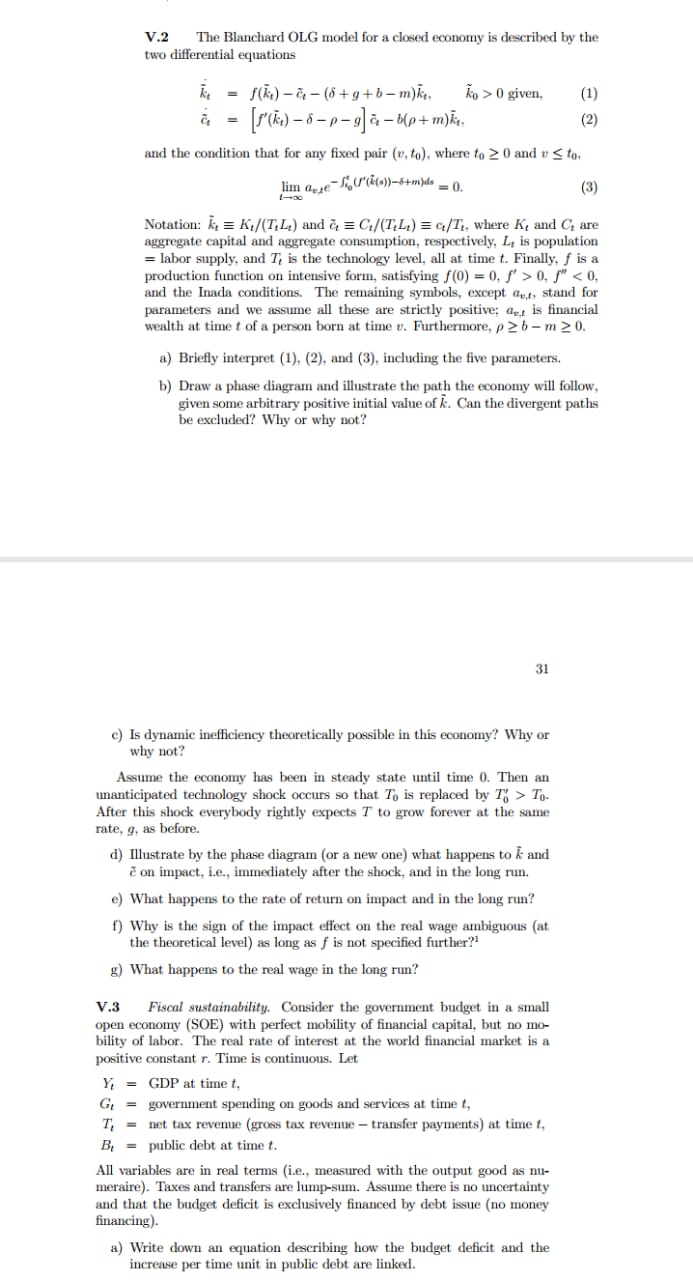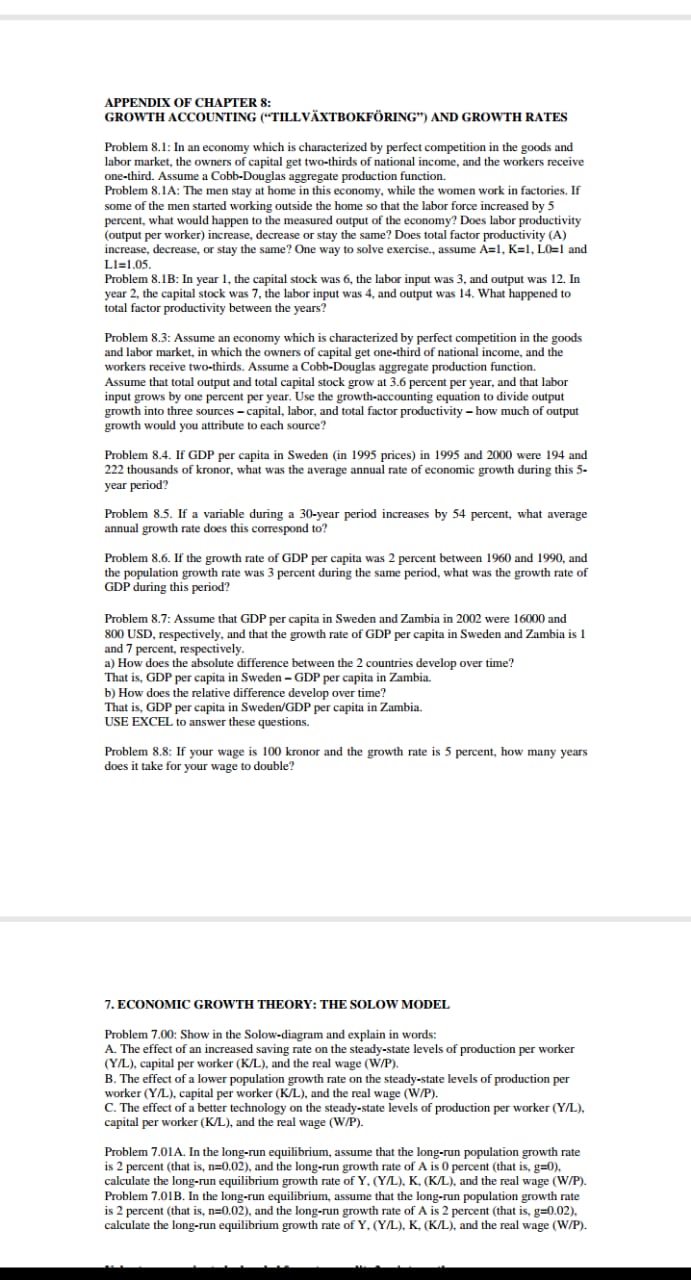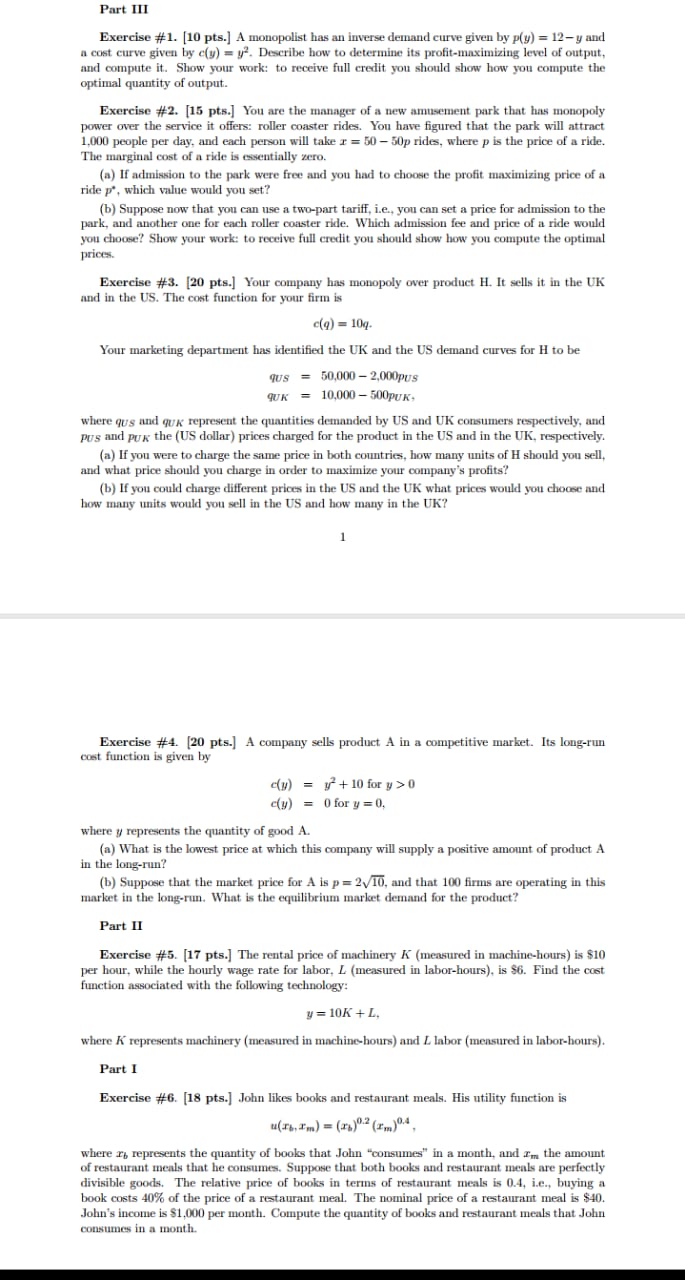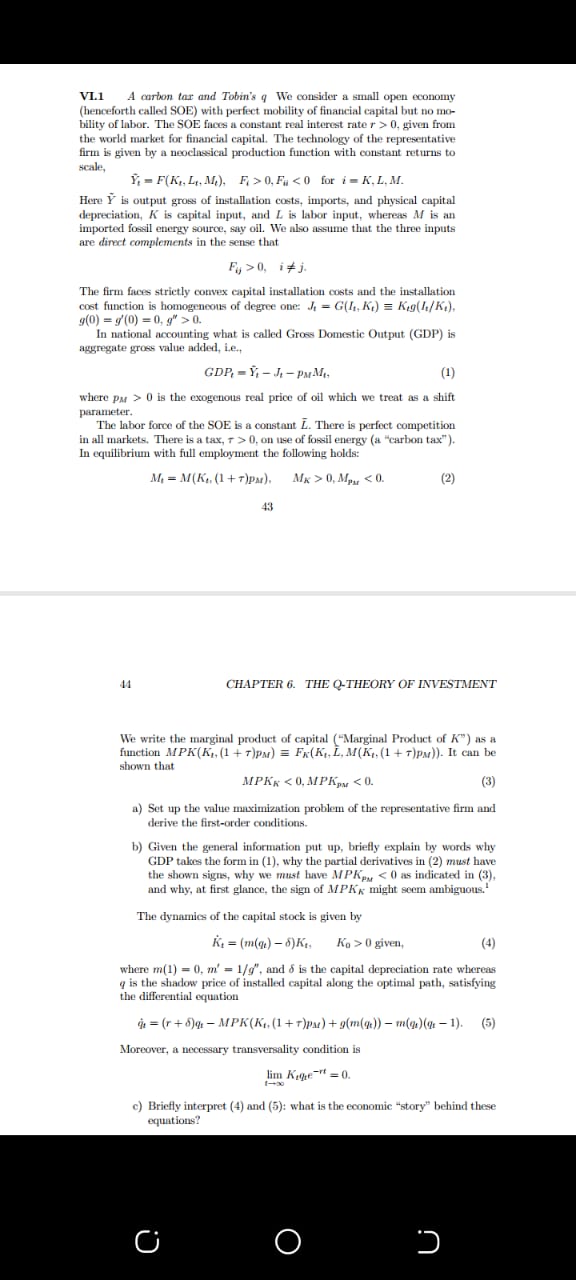



Thanks in advance...detailed explanation
V.2 The Blanchard OLG model for a closed economy is described by the two differential equations k = [( k) - a - (8 +g+b-m)k. ko> 0 given, (1) a = [5( in) - 8 - p-ga- b(p+ m)k, (2) and the condition that for any fixed pair (v, to), where to 2 0 and v S to. lim dare- fio(((-))-5+mydo = 0. (3) Notation: K, = Ki/(T,L,) and & = Ci/(T,L.) = c/It, where K, and C are aggregate capital and aggregate consumption, respectively, L, is population = labor supply, and 7, is the technology level, all at time t. Finally, f is a production function on intensive form, satisfying f (0) = 0, S' > 0, f" To- After this shock everybody rightly expects T to grow forever at the same rate, g, as before. d) Illustrate by the phase diagram (or a new one) what happens to & and on impact, i.e., immediately after the shock, and in the long run. e) What happens to the rate of return on impact and in the long run? f) Why is the sign of the impact effect on the real wage ambiguous (at the theoretical level) as long as f is not specified further? g) What happens to the real wage in the long run? V.3 Fiscal sustainability. Consider the government budget in a small open economy (SOE) with perfect mobility of financial capital, but no mo- bility of labor. The real rate of interest at the world financial market is a positive constant r. Time is continuous. Let Y = GDP at time t. Ge = government spending on goods and services at time f, T, = net tax revenue (gross tax revenue - transfer payments) at time f, Be = public debt at time t. All variables are in real terms (i.e., measured with the output good as nu- meraire). Taxes and transfers are lump-sum. Assume there is no uncertainty and that the budget deficit is exclusively financed by debt issue (no money financing). a) Write down an equation describing how the budget deficit and the increase per time unit in public debt are linked.APPENDIX OF CHAPTER 8: GROWTH ACCOUNTING ("TILL VAXTBOKFORING") AND GROWTH RATES Problem 8.1: In an economy which is characterized by perfect competition in the goods and labor market, the owners of capital get two-thirds of national income, and the workers receive one-third. Assume a Cobb-Douglas aggregate production function. Problem 8. 1A: The men stay at home in this economy, while the women work in factories. If some of the men started working outside the home so that the labor force increased by 5 percent, what would happen to the measured output of the economy? Does labor productivity output per worker) increase, decrease or stay the same? Does total factor productivity (A) increase, decrease, or stay the same? One way to solve exercise., assume A=l, Kel, LO=] and LI=1.05. Problem 8.1B: In year 1, the capital stock was 6, the labor input was 3, and output was 12. In year 2, the capital stock was 7, the labor input was 4, and output was 14. What happened to total factor productivity between the years? Problem 8.3: Assume an economy which is characterized by perfect competition in the goods and labor market, in which the owners of capital get one-third of national income, and the workers receive two-thirds. Assume a Cobb-Douglas aggregate production function. Assume that total output and total capital stock grow at 3.6 percent per year, and that labor input grows by one percent per year. Use the growth-accounting equation to divide output growth into three sources - capital, labor, and total factor productivity - how much of output growth would you attribute to each source? Problem 8.4. If GDP per capita in Sweden (in 1995 prices) in 1995 and 2000 were 194 and 222 thousands of kronor, what was the average annual rate of economic growth during this 5- year period? Problem 8.5. If a variable during a 30-year period increases by 54 percent, what average annual growth rate does this correspond to? Problem 8.6. If the growth rate of GDP per capita was 2 percent between 1960 and 1990, and the population growth rate was 3 percent during the same period, what was the growth rate of GDP during this period? Problem 8.7: Assume that GDP per capita in Sweden and Zambia in 2002 were 16000 and 800 USD, respectively, and that the growth rate of GDP per capita in Sweden and Zambia is 1 and 7 percent, respectively. a) How does the absolute difference between the 2 countries develop over time? That is, GDP per capita in Sweden - GDP per capita in Zambia. b) How does the relative difference develop over time? That is, GDP per capita in Sweden/GDP per capita in Zambia. USE EXCEL to answer these questions. Problem 8.8: If your wage is 100 kronor and the growth rate is 5 percent, how many years does it take for your wage to double? 7. ECONOMIC GROWTH THEORY: THE SOLOW MODEL Problem 7.00: Show in the Solow-diagram and explain in words: A. The effect of an increased saving rate on the steady-state levels of production per worker (Y/L), capital per worker (K/L), and the real wage (W/P). B. The effect of a lower population growth rate on the steady-state levels of production per worker (Y/L), capital per worker (K/L), and the real wage (W/P). C. The effect of a better technology on the steady-state levels of production per worker (Y/L). capital per worker (K/L), and the real wage (W/P). Problem 7.01A. In the long-run equilibrium, assume that the long-run population growth rate is 2 percent (that is, n=0.02), and the long-run growth rate of A is 0 percent (that is, g=0), calculate the long-run equilibrium growth rate of Y, (Y/L). K. (K/L), and the real wage (W/P). Problem 7.01B. In the long-run equilibrium, assume that the long-run population growth rate is 2 percent (that is, n=0.02), and the long-run growth rate of A is 2 percent (that is, g=0.02). calculate the long-run equilibrium growth rate of Y, (Y/L), K. (K/L), and the real wage (W/P).Part III Exercise #1. [10 pts.] A monopolist has an inverse demand curve given by p(y) = 12-y and a cost curve given by c(y) = y". Describe how to determine its profit-maximizing level of output, and compute it. Show your work: to receive full credit you should show how you compute the optimal quantity of output. Exercise #2. [15 pts.] You are the manager of a new amusement park that has monopoly power over the service it offers: roller coaster rides. You have figured that the park will attract 1,000 people per day, and each person will take a = 50 - 50p rides, where p is the price of a ride. The marginal cost of a ride is essentially zero. (a) If admission to the park were free and you had to choose the profit maximizing price of a ride p', which value would you set? (b) Suppose now that you can use a two-part tariff, i.e., you can set a price for admission to the park, and another one for each roller coaster ride. Which admission fee and price of a ride would you choose? Show your work: to receive full credit you should show how you compute the optimal prices. Exercise #3. [20 pts.] Your company has monopoly over product H. It sells it in the UK and in the US. The cost function for your firm is c(q) = 10q. Your marketing department has identified the UK and the US demand curves for H to be qV8 = 50,000 - 2,000pus qUK = 10,000 - 500PUK; where qus and qui represent the quantities demanded by US and UK consumers respectively, and pus and pux the (US dollar) prices charged for the product in the US and in the UK, respectively. (a) If you were to charge the same price in both countries, how many units of H should you sell, and what price should you charge in order to maximize your company's profits? (b) If you could charge different prices in the US and the UK what prices would you choose and how many units would you sell in the US and how many in the UK? Exercise #4. [20 pts.] A company sells product A in a competitive market. Its long-run cost function is given by "(y) = y + 10 for y >0 c(y) = 0 for y = 0, where y represents the quantity of good A. (a) What is the lowest price at which this company will supply a positive amount of product A in the long-run? (b) Suppose that the market price for A is p = 2v10, and that 100 firms are operating in this market in the long-run. What is the equilibrium market demand for the product? Part II Exercise #5. [17 pts.] The rental price of machinery K (measured in machine-hours) is $10 per hour, while the hourly wage rate for labor, L (measured in labor-hours), is $6. Find the cost function associated with the following technology: y = 10K + L, where K represents machinery (measured in machine-hours) and L labor (measured in labor-hours). Part I Exercise #6. [18 pts.] John likes books and restaurant meals. His utility function is u(It, I'm) = (1)02 (1m)0.4 where r; represents the quantity of books that John "consumes" in a month, and Im the amount of restaurant meals that he consumes. Suppose that both books and restaurant meals are perfectly divisible goods. The relative price of books in terms of restaurant meals is 0.4, i.e., buying a book costs 40% of the price of a restaurant meal. The nominal price of a restaurant meal is $40. John's income is $1,000 per month. Compute the quantity of books and restaurant meals that John consumes in a month.VI.I A carbon tar and Tobin's q We consider a small open economy (henceforth called SOE) with perfect mobility of financial capital but no mo- bility of labor. The SOE faces a constant real interest rate r > 0, given from the world market for financial capital. The technology of the representative firm is given by a neoclassical production function with constant returns to scale, Y, = F(Ki, Ly, Me), F. > 0, F. 0, ifj. The firm faces strictly convex capital installation costs and the installation cost function is homogeneous of degree one: J = G(1, K;) = Kig(1/ K.). 4(0) = '(0) = 0, g" > 0. In national accounting what is called Gross Domestic Output (GDP) is aggregate gross value added, Le., GDP, = Y - J- PMML (1) where pur > 0 is the exogenous real price of oil which we treat as a shift parameter. The labor force of the SOE is a constant L. There is perfect competition in all markets. There is a tax, + > 0, on use of fossil energy (a "carbon tax"). In equilibrium with full employment the following holds: M. = M(K., (1 + 7)PM). My > 0, Mp. 0 given, (4) where m(1) = 0, m' = 1/g", and & is the capital depreciation rate whereas g is the shadow price of installed capital along the optimal path, satisfying the differential equation i = (r+5) - MPK(K, (1 + +)PM) + 9(m(q:)) - m(g.)(q -1). (5) Moreover, a necessary transversality condition is lim Kage " = 0. c) Briefly interpret (4) and (5): what is the economic "story" behind these equations? O C














